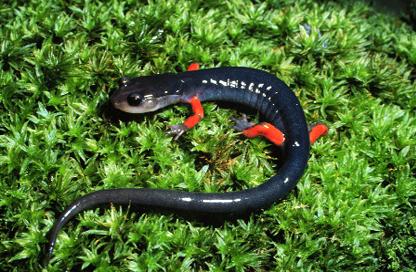


|
Plethodontidae :
Generalized in body form with four fingers and five toes (except when reduced to four toes in miniaturized species). The largest family of extant salamanders with over 350 species. All members of this assemblage lack lungs and possess naso-labial grooves which aid in chemoreception. This group was thought to have arisen out of the Appalachian Mountains in the eastern United States. Members within this group have adapted to stream, arboreal, terrestrial, fossorial (underground) and cave habitats. Currently there are two subfamilies, the Desmognathinae and Plethodontinae, of which the latter is the largest and has individuals capable of ballistically projecting their tongue (along with tongue skeleton) to capture prey (as in Hydromantes) as well as having webbed feet (tribe Bolitoglossini). Most species are direct developers. With the exception of six species in the Middle Western Mediterranean in Europe (members of the genus Hydromantes, which also occurs in California) this family is mainly new world and extends from southern Canada down to Bolivia and Brazil. It includes the only family of tropical salamanders which account for about 2/3 of the species and 40% of all salamanders. Some morphological characters for this group are: 1) pterygoid absent; 2) nasolabial groove present; 3) lacrimals absent; 4) otic and occipital elements fused; 5) elongate, up to 60 vertebrae.
Genus:
Aneides (6 species)
Batrachoseps (20 species)
Bolitoglossa (92 species)
Bradytriton (1 species)
Chiropterotriton (12 species)
Cryptotriton (6 species)
Dendrotriton (6 species)
Desmognathus (19 species)
Ensatina (1 species)
Eurycea (26 species)
Gyrinophilus (4 species)
Haideotriton (1 species)
Hemidactylium (1 species)
Hydromantes (10 species)
Ixalotriton (2 species)
Karsenia (1 species)
Lineatriton (3 species)
Nototriton (13 species)
Nyctanolis (1 species)
Oedipina (24 species)
Parvimolge (1 species)
Phaeognathus (1 species)
Plethodon (55 species)
Pseudoeurycea (45 species)
Pseudotriton (2 species)
Stereochilus (1 species)
Thorius (23 species)
|
